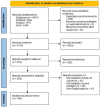A scoping review of COVID-19 vaccine hesitancy: refusal rate, associated factors, and strategies to reduce
- PMID: 39473604
- PMCID: PMC11518786
- DOI: 10.3389/fpubh.2024.1382849
A scoping review of COVID-19 vaccine hesitancy: refusal rate, associated factors, and strategies to reduce
Abstract
Objective: This study aimed to investigate the evidence regarding vaccine hesitancy including refusal rate, associated factors, and potential strategies to reduce it.
Methods: This is a scoping review. Three main databases such as PubMed, Scopus, and Web of Science were searched from 1 January 2020 to 1 January 2023. All original studies in the English language that investigated one of our domains (vaccine hesitancy rate, factors associated with vaccine hesitancy, and the ways/interventions to overcome or decrease vaccine hesitancy) among the general population were included in this study. The data were charted using tables and figures. In addition, a content analysis was conducted using the 3C model of vaccine hesitancy (Confidence, Complacency, and Convenience) that was previously introduced by the WHO.
Results: Finally, 184 studies were included in this review. Of these, 165, 181, and 124 studies reported the vaccine hesitancy rate, associated factors, and interventions to reduce or overcome vaccine hesitancy, respectively. Factors affecting the hesitancy rate were categorized into 4 themes and 18 sub-themes (contextual factors, confidence barriers, complacency barriers, and convenience barriers).
Conclusion: Vaccine hesitancy (VH) rate and the factors affecting it are different according to different populations, contexts, and data collection tools that need to be investigated in specific populations and contexts. The need to conduct studies at the national and international levels regarding the reasons for vaccine refusal, the factors affecting it, and ways to deal with it still remains. Designing a comprehensive tool will facilitate comparisons between different populations and different locations.
Keywords: COVID-19; refusal rate; scoping review; strategy; vaccine hesitancy.
Copyright © 2024 Bahreini, Sardareh and Arab-Zozani.
Conflict of interest statement
The authors declare that the research was conducted in the absence of any commercial or financial relationships that could be construed as a potential conflict of interest. The author(s) declared that they were an editorial board member of Frontiers, at the time of submission. This had no impact on the peer review process and the final decision.
Figures
Similar articles
-
Understanding the COVID-19 vaccine uptake, acceptance, and hesitancy in Ethiopia and Tanzania: a scoping review.Front Public Health. 2024 Nov 11;12:1422673. doi: 10.3389/fpubh.2024.1422673. eCollection 2024. Front Public Health. 2024. PMID: 39588164 Free PMC article.
-
Attitudes and beliefs of healthcare providers toward vaccination in the United States: A cross-sectional online survey.Vaccine. 2024 Dec 2;42(26):126437. doi: 10.1016/j.vaccine.2024.126437. Epub 2024 Oct 16. Vaccine. 2024. PMID: 39418687
-
Vaccine hesitancy among Syrian refugee parents in Canada: A multifaceted challenge in public health.Hum Vaccin Immunother. 2024 Dec 31;20(1):2430086. doi: 10.1080/21645515.2024.2430086. Epub 2024 Dec 1. Hum Vaccin Immunother. 2024. PMID: 39618040 Free PMC article.
-
Relationship between parental acceptance of the COVID-19 vaccine and attitudes towards measles vaccination for children: A cross-sectional study.Vaccine. 2024 Oct 24;42(24):126068. doi: 10.1016/j.vaccine.2024.06.035. Epub 2024 Jun 16. Vaccine. 2024. PMID: 38880690
-
Interventions to increase COVID-19 vaccine uptake: a scoping review.Cochrane Database Syst Rev. 2022 Aug 3;8(8):CD015270. doi: 10.1002/14651858.CD015270. Cochrane Database Syst Rev. 2022. PMID: 35920693 Free PMC article.
References
-
- Cénat JM, Noorishad PG, Moshirian Farahi SMM, Darius WP, Mesbahi El Aouame A, Onesi O, et al. . Prevalence and factors related to COVID-19 vaccine hesitancy and unwillingness in Canada: a systematic review and meta-analysis. J Med Virol. (2023) 95:e28156. doi: 10.1002/jmv.28156, PMID: - DOI - PMC - PubMed
-
- Carcelen AC, Prosperi C, Mutembo S, Chongwe G, Mwansa FD, Ndubani P, et al. . COVID-19 vaccine hesitancy in Zambia: a glimpse at the possible challenges ahead for COVID-19 vaccination rollout in sub-Saharan Africa. Hum Vaccin Immunother. (2022) 18:1–6. doi: 10.1080/21645515.2021.1948784, PMID: - DOI - PMC - PubMed
Publication types
MeSH terms
Substances
LinkOut - more resources
Full Text Sources
Medical



